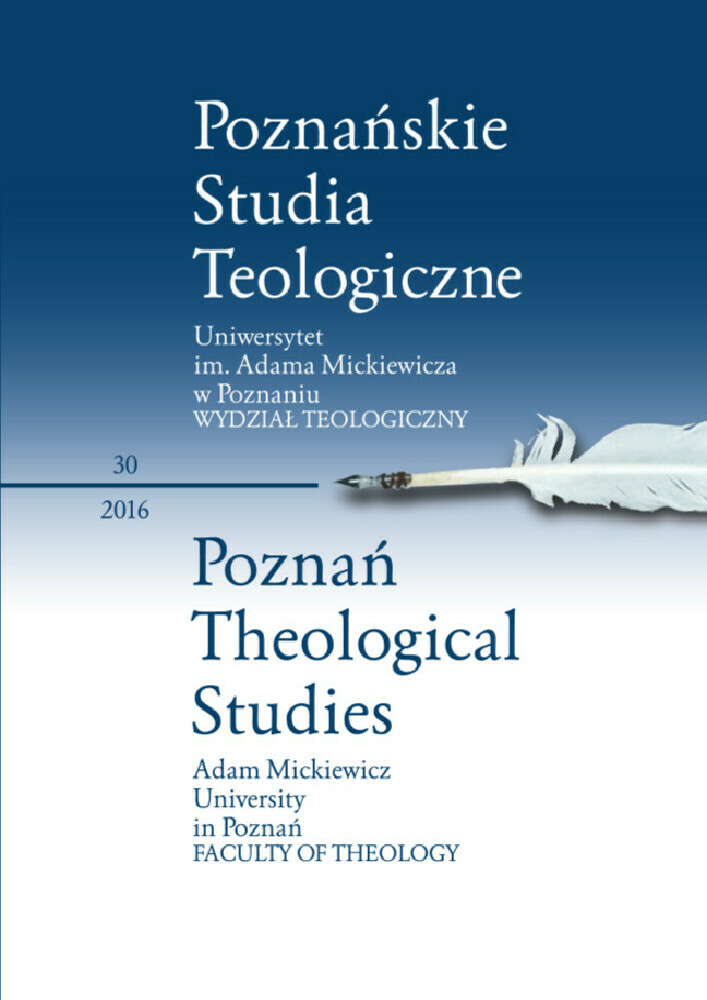Abstrakt
There is no doubt that in Jesus’ times the three ancient languages, Hebrew, Aramaic, and Greek were commonly spoken in Roman Palestine. It is also beyond discussion that Jesus’ mother tongue was Aramaic.
There are many Aramaic wordings in the Greek New Testament that are hinting at the original language of Jesus’ sermons. The aim of this paper is to investigate three Aramaic phrases in the Greek Gospels: Jesus’ cry from the cross (Eli, Eli, lema sabachthani?; Mt 27:46; Mk 15:34), his command to the daughter of Jairus (Talitha koum; Mk 5:41) and his allusion to Aramaic characters (iōta – keraia; Mt 5:18).
Furthermore, there are also many Aramaic common words and proper names (personal and place names) in the Greek New Testament. They will require an extra future research.
Bibliografia
Bartnicki R., Jezus jako Głosiciel Ewangelii, „Warszawskie Studia Teologiczne” 27(2014) 1, s. 51-85.
Dąbek T., „Dopóki niebo i ziemia nie przeminą, ani jedna jota, ani jedna kreska nie zmieni się w Prawie, aż się wszystko spełni” (Mt 5,18), w: Pan moim światłem. Księga pamiątkowa dla Księdza Profesora Jerzego Chmiela w 65. rocznicę urodzin, red. W. Chrostowski, Warszawa 2000, s. 148-158.
Fitzmyer J., The Aramaic language and the study of the New Testament, „Journal of Biblical Literature” 99(1980) 1, s. 5-21.
Hurst L., The neglected role of semantics in the search for the Aramaic words of Jesus, „Journal for the Study of the New Testament” 28(1986), s. 63-80.
Jaromin J. Siedem słów z krzyża, „Scriptura Sacra” 2(2008), s. 117-130.
Kahle P., Das zur Zeit Jesu in Palästina gesprochene Aramäisch, „Theologische Rundschau” 17(1949) 3, s. 201-216.
Klawek A., Eli, Eli, lamma sabachthani, „Tygodnik Powszechny” 8(1952) 14, s. 2.
Knox B., The Aramaic background of the Gospels, „Reformed Theological Review” 6(1947) 2, s. 24-29.
McDaniel Th., Clarifying New Testament Aramaic names & words and Shem Tob’s Hebrew Gospel of Matthew, Winnewood 2008.
Montgomery J., Some Aramaisms in the Gospels and Acts, „Journal of Biblical Literature” 46(1927) 1-2, s. 69-73.
Napora K., Thalitha kum, „Czas Serca” 22(2012) 4, s. 38-39.
Ostański P., Języki używane przez Jezusa na tle sytuacji językowej w rzymskiej Palestynie, „Wrocławski Przegląd Teologiczny” 23(2015) 2, s. 45-74.
Paciorek A., Psałterz w Mateuszowym opisie Męki Jezusa, „Roczniki Biblijne” 1(2009), s. 177-189.
Pawlak L., „Boże mój, Boże mój, czemuś Mnie...?” (Ps 22,2). Z Jezusem na krzyżu (Mt 27,46; Mk 15,34), „Słowo Krzyża” 6(2012), 79-84.
Rubinkiewicz R., Mk 15,34 i Hbr 1,8-9 w świetle tradycji targumicznej, „Roczniki Teologiczno-Kanoniczne” 25(1978) 1, 60-67.
Segert S., The languages of historical Jesus, „Communio Viatorum” 44(2002) 2, s. 161-173.
Selby G., The language in which Jesus taught, „Theology” 86(1983) 711, s. 185-193.
Stefański J., Odkryć Chrystusa przez hebrajskie słowa Psalmu 22 na Golgocie, „Studia Gdańskie” 37(2015), s. 37-49.
Szmajdziński M., Język aramejski. „Lingua franca” starożytnego Bliskiego Wschodu, w: „Gloriam praecedit humilitas” (Prz 15,33). Księga Pamiątkowa dla Księdza Profesora Antoniego Troniny w 70. rocznicę urodzin, red. M. Szmajdziński, Częstochowa 2015, s. 737-755.
Torrey Ch, The Aramaic of the Gospels, „Journal of Biblical Literature” 61(1942) 2, s. 71-85.
Tresham A., The languages spoken by Jesus, „Master’s Seminary Journal” 20(2009) 1, s. 71-94.
Zawadzki R., The prayer of Jesus on the cross, „Verbum Vitae” 11(2012) 22, s. 93-110.
Zbroja B., Teologia wypowiedzi Jezusa z krzyża, „Ruch Biblijny i Liturgiczny” 65(2012) 3, s. 211-224.
Licencja
Copyright
© 2016 Uniwersytet im. Adama Mickiewicza w Poznaniu, Wydawnictwo Naukowe UAM, Poznań
OPEN ACCESS
